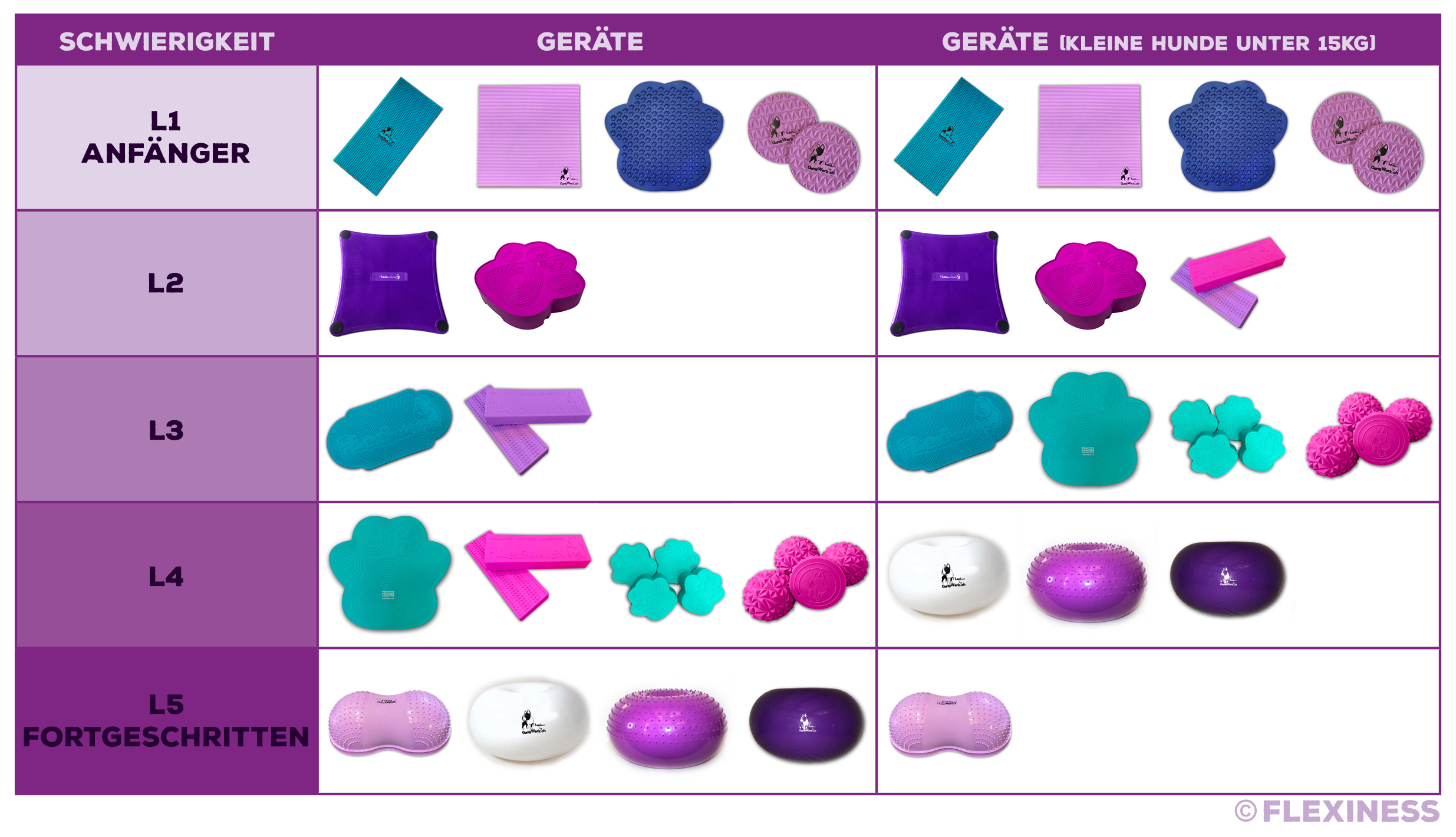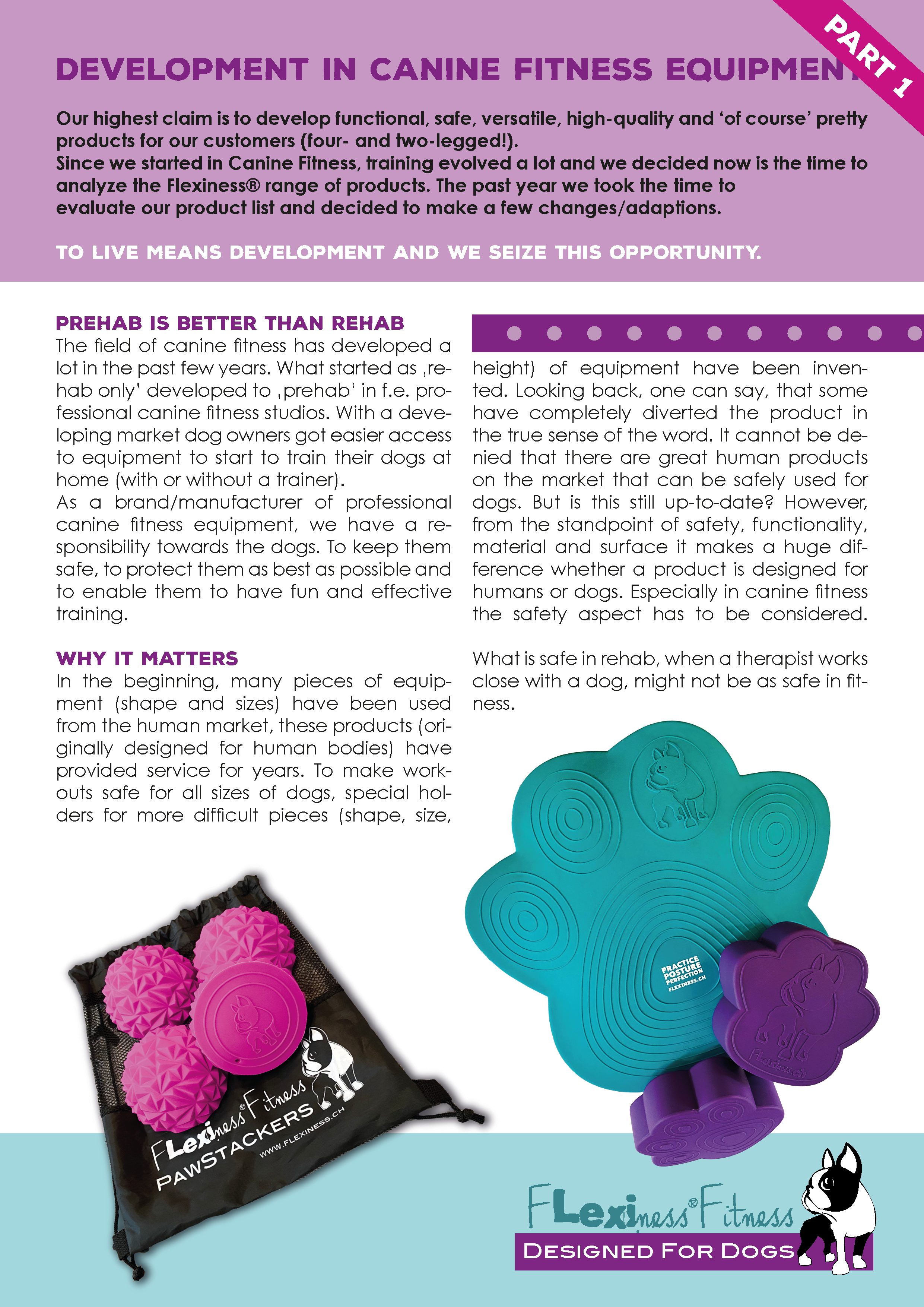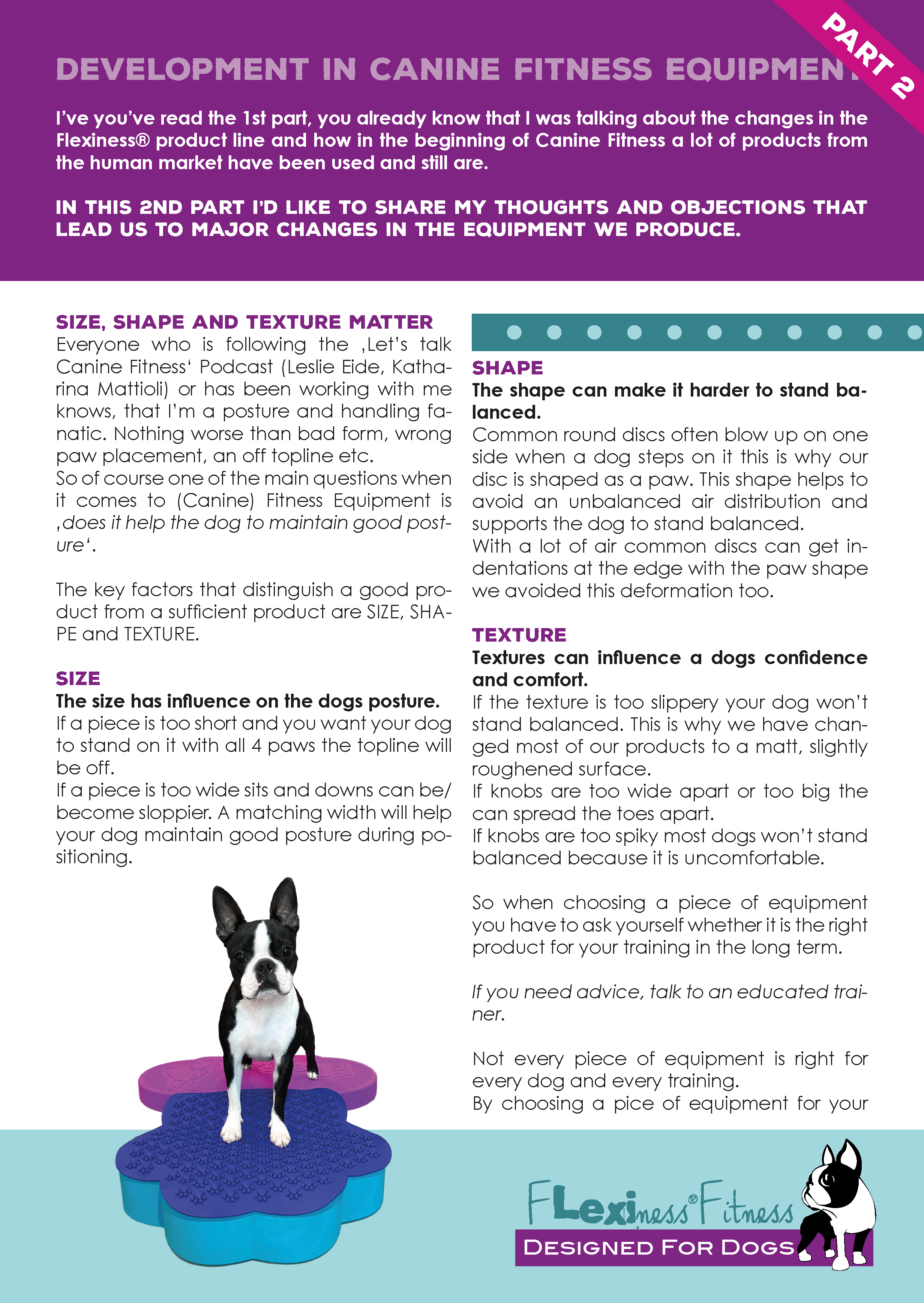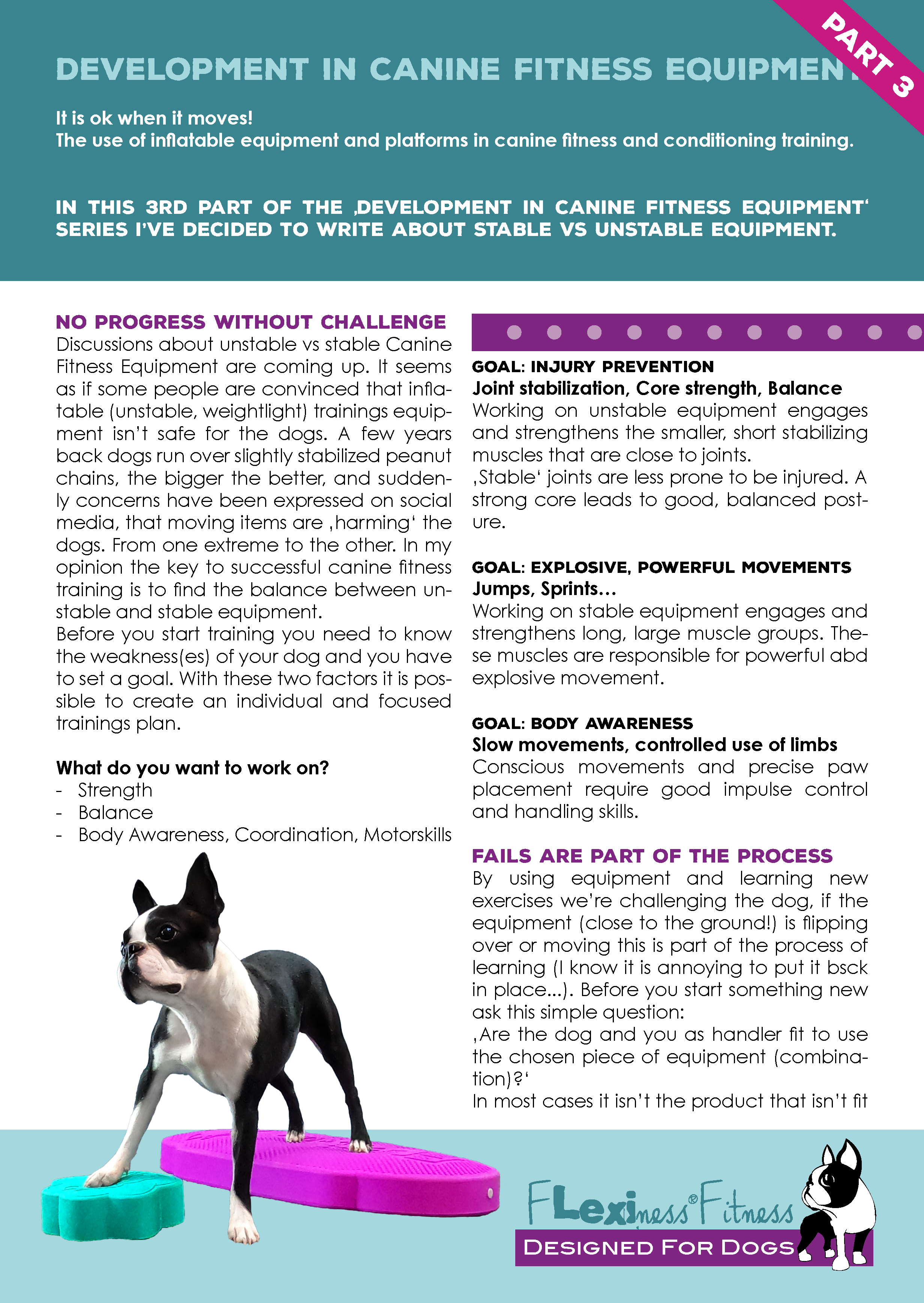equipment 1×1
Not every device is suitable for every dog or every training
To meet all dogs’ needs, we design different devices with different intensity levels from stable to unstable!
It is a sport!
Train smart and treat your dogs like the athletes they are!
It makes me happy to see more and more people getting into dog fitness because they realize how much dogs can benefit from targeted active exercise.
It’s true, the process begins with the decision to take the first step. But it can’t stay that way. As dog owners, trainers and/or therapists active in dog fitness, we owe it to our dogs to continually expand our knowledge. The field of dog fitness has evolved significantly since its inception and we must adapt the methods, training, therapies and equipment we use to provide the best possible support for our dogs.
Compared to humans, it is similar to someone who starts jogging to get fit and lose weight after not exercising for years. Normally, in such a situation, someone will use the sneakers lying around or, if they buy new ones, a cheaper option. Over time, this person will realize (often due to pain or injury) that they really need a personal training plan and appropriate equipment (shoes) to achieve the goal without harming the body.
We must remember that the body of a healthy young dog is much more forgiving than the body of an older dog or a dog with pre-existing conditions.
When it comes to equipment, some shapes, material compositions or combinations are simply not ideal for supporting physiologically good posture. When training, it is crucial to work with and towards the best possible posture.
It is also a fact that exercises and equipment may make sense in fitness but may not be suitable for rehabilitation and vice versa.
Size, height, shape, texture, stability/instability are just a few indicators we need to consider when it comes to choosing the right equipment. Age, condition, goal and the exercises chosen are also important factors.
A few Tipps:
- Using two smaller devices is often safer and offers more options than using one large, very unstable device.
- A circular shape (sized for 2 or more paws) is not ideal for working on parallel limb/paw placement and overall balanced stance.
- When a dog is recovering from an injury, use more stable equipment rather than very unstable equipment to avoid uncontrolled movements that could set back the healing process (always work with a professional).
- Work goal-oriented.
These are just a few pointers. If you would like to know or learn more, contact us for detailed information about our training offerings.
Our products are designed for the dog’s body and produced according to humane requirements from harmless materials.
The devices should always be
- chosen according
- the dog’s fitness level,
- goal of the training
and ability of the dog!
If you are unsure, we are happy to help!
Flexiness® Equipment FAQ
How do I inflate the devices?
The Flexiness® devices can be inflated with a standard ball or bicycle pump. With caution you can also use a compressor. For reasons of sustainability, we intentionally refrain from supplying a pump with every device.
Please note that the amount of air in the devices has an influence on training. The firmer the equipment and the lighter the dog, the lower the resistance and, consequently, the lesser the training effect. It should also be noted that most devices become less stable with more air. When adjusting the amount of air, the age and fitness level of the dog must always be taken into account. If in doubt, contact your veterinarian or therapist.
As already described at the beginning, we do not supply pumps or attachments with the products for reasons of sustainability. If a suitable attachment for your bicycle pump or compressor is not readily available, we’re happy to help!
Which device requires which attachment?
Flexiness® Donuts, Peanuts, TwinDisc, PawDisc, Cloud
These devices do not have a valve and only require an attachment that fits into the opening.
2. Flexiness® PawStackers, ToyPawStackers, StackingBars, DonutDisc (available from us)
These devices require a needle attachment. To regulate air in the devices, simply insert the attachment into the valve without a pump. By pressing on the device, air escapes through the opening of the attachment.
3. Flexiness®FitStages (available from us)

Size Donuts/Peanuts?
After the devices have been inflated for the first time, please pump them again after approx. 2-3 days so that they can develop their full size. The final size of the Peanuts & Donuts* is typically reached only a few weeks after the initial inflation. The amount of air also determines the size of the donut/peanut. It may happen that a device is not 100% horizontal due to production reasons. However, the slight slope has no influence on the quality of the device or training. You can even see this as an extra challenge.
* The sizes given are guidelines, depending on the amount of air, this can vary greatly.
How can I clean the devices?
The devices can be easily cleaned with diluted soapy water or glass cleaner. For hygiene reasons, we recommend doing this regularly. This also makes the surface more grippy again and greatly reduces the possibility of slipping.
Attention:
If the devices:
- are cleaned with harsh cleaners,
- combined with other products (not from Flexiness®),
- used with holders,
- are exposed to strong sunlight,
we do not take responsibility for any potential damage.
Lifespan?
The lifespan of the devices is determined by how they are handled and how intensively they are used. To avoid damage, the devices should no be stored near a heat source. It should also be noted that warm air expands. The inflatable devices* are not bite-proof. Please pay attention to good nail care, pointy and/or sharp nails can damage the inflatable device. Pointed or sharp objects can damage the device – pay attention to the condition of the floor.
Attention:
If the devices:
- are cleaned with harsh cleaners,
- combined with other products (not from Flexiness®),
- used with holders,
- are exposed to strong sunlight,
we do not take responsibility for any potential damage.
* especially Donuts
Maximum load on the devices?
The maximum load on the devices is 150kg (even). FlexBox 100 kg
Guarantee?
As a producer, Gangwerk GmbH guarantees the buyer that this product is free from manufacturing defects* for a period of 30 days from the invoice date. If your product shows signs of defective manufacturing during this period, please contact us immediately.
* Slight production-related deviations in shape and color are not considered errors.
Attention:
If the devices:
- are cleaned with harsh cleaners,
- combined with other products (not from Flexiness®),
- used with holders,
- are exposed to strong sunlight,
we do not take responsibility for any potential damage.
Training?
To prevent slipping and sliding, always train on a non-slip surface. For beginners, it’s advisable to start with ground-level equipment. Don’t forget to warm up your dog for about 5 minutes at a relaxed trot before each training session.
The Flexiness® devices are not toys but training tools. NEVER leave the dog unsecured or unsupervised and put away the equipment after training.
Flexiness®FitStage 1x1
The lid above the valve must be opened by turning it to the left. Then screw the adapter or pump attachment into the valve (to the right). Before screwing it in, ensure that the small, centrally placed button in the valve is always set to ‘open’. If it is pushed in, the device cannot be inflated because the air keeps escaping as soon as the pump or adapter is removed.
Please always inflate the Flexiness®FitStage completely (no wrinkles!) to avoid damage to the product. The small button in the valve allows the amount of air to be regulated very well with small, short pressure bursts.
If you ever get a hole in the FitStage due to external influences, the FitStage can be repaired with appropriate repair material (for SUPs, boats, etc.). We’re happy to help. Simply water or diluted dish soap is suitable for cleaning. We recommend our Flexiness®SensiMats and SensiTargets as supports.




